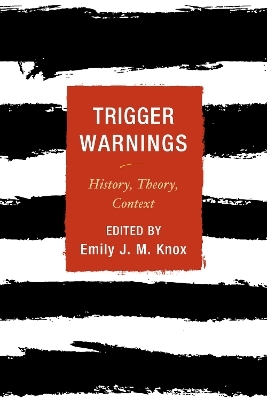
Trigger Warnings
Rowman & Littlefield (Verlag)
978-1-5381-8353-3 (ISBN)
With “triggered” as Google’s most searched word of 2016, trigger warnings have become a prevalent yet controversial concept in American higher education and society. As the debate over the value and place of triggering material continues, Trigger Warnings: History, Theory, Context provides the historical context and theoretical analysis of the use of trigger and content warnings in academia. This important edited collection examines the history, theories, and ethics of trigger warnings and presents case studies from instructors and students describing instances when trigger warnings were and were not used. By exploring the issue through several scholarly lenses and providing examples of when trigger warnings may or may not be used effectively, Trigger Warnings provides rigorous analysis of the controversy
Emily J. M. Knox is assistant professor in the School of Information Sciences at the University of Illinois at Urbana–Champaign. Her research interests include information access, intellectual freedom and censorship, information ethics, information policy, and the intersection of print culture and reading practices. Knox’s book Book Banning in 21st-Century America (Rowman & Littlefield, 2015) is the first monograph in the Beta Phi Mu Scholars Series.
Introduction. On Trigger Warnings
Emily J.M. Knox
Part I: History and Theory
Chapter 1. Like Trapdoors: A History of Post-Traumatic Stress Disorder and the Trigger Warning
Sarah Colbert
Chapter 2. Accessibility on Campus: Post-Traumatic Stress Disorder, Duty to Accommodate, and Trigger Warnings
Holly Taylor
Chapter 3. Contagious Speech: Mediating the Eating Disorder Panic Through Trigger Warnings
Stephanie Grey
Chapter 4. Gender Constructions and Trauma: Trigger Warnings as an Accommodation for Female Students in Higher Education
Jordan Doll
Chapter 5. Walking on the Shards of the Glass Ceiling
Jane Gavin-Hebert
Chapter 6. An “App” for That: The Case Against an ‘Equal Access’
Bonnie Washick
Chapter 7. Writing Policy About Trigger Warnings: The Experience of the American Association of University Professors and the American Library Association
Barbara M. Jones
Part II: Case Studies
Chapter 8. Institution-Wide Trigger Warnings: A Case Study of a University’s ‘Common Reading’
Joe C. Martin & Brandi N. Frisby
Chapter 9. On Privilege, Authority, and Abuses of Professional Power
Jami McFarland
Chapter 10. Trigger Warnings, Protectionism, and the Feminist Student Subject
Pinky Hota
Chapter 11. Beyond Trigger Warnings: Handling Traumatic Topics in Classroom Discussion
Kari Storla
Chapter 12. Adapting Trigger Warnings in the Introduction to Women’s Studies Course: A Case Study
Elizabeth Tolman
Chapter 13. Trigger Warning Expectations: Potential Ripples and Ramifications
Susan Stearns
Chapter 14. Lived Experiences of Military Veterans in the College English Classroom: A Case Study
Gretchen Oltman & Kristine Leibhart
Chapter 15. Trigger Warnings to Protect Learning: A Case Study in Public Speaking
Kristina Ruiz-Mesa, Julie Matos & Gregory Langner
Chapter 16. Teaching Disruptive Literature in Precarious Times: A Case Study from Library and Information Science
Davin Helkenberg
| Erscheinungsdatum | 28.03.2023 |
|---|---|
| Verlagsort | Lanham, MD |
| Sprache | englisch |
| Maße | 151 x 228 mm |
| Gewicht | 449 g |
| Themenwelt | Sozialwissenschaften ► Kommunikation / Medien ► Buchhandel / Bibliothekswesen |
| Sozialwissenschaften ► Kommunikation / Medien ► Journalistik | |
| Sozialwissenschaften ► Kommunikation / Medien ► Kommunikationswissenschaft | |
| ISBN-10 | 1-5381-8353-6 / 1538183536 |
| ISBN-13 | 978-1-5381-8353-3 / 9781538183533 |
| Zustand | Neuware |
| Haben Sie eine Frage zum Produkt? |
aus dem Bereich


